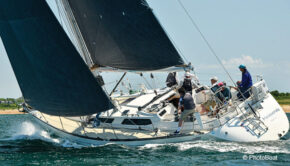How to develop both passion and skill
Published on April 25th, 2021
If you provide youth sailors with limited options to enjoy the sport, they will either embrace them or choose another sport. But if you increase the options, well, you improve the odds of minimizing attrition. There is a reason why ice cream stores offer an assortment of flavors.
Chris Bulger provides his perspective as a parent who sought to expand the options:
I was very glad to see the report by Phillip Muller on the 29er as a great gateway youth boat. The value of the 29er – which I will expand on below – has been clear to the top sailing nations for two decades.
Despite the lack of a fleet – we bought one for my son 14 years ago here on Narragansett Bay and it kept him in the sport. He had grown up sailing – lucky enough to do 1000s of miles of blue water sailing including a Bermuda Race before he was 11. He found the technical slow world of Optis and Club 420s boring, but when he got a 29er, we couldn’t get him out of the boat and he developed both passion and skills.
As Muller suggested, this led to him being recruited by top level international programs – the Extreme Sailing global circuit, helping team Canada win the Canada’s Cup, and helping the Samba team win the Melges 32 Worlds … to name a few of the opportunities that came his way.
The benefits of the 29er are incredible – it may well be the best dinghy design ever. Why? Because it offers an incredible high-performance sailing experience in a durable package. Most high-performance boats require many hours of boat park work for each hour of sailing – not the 29er. The boat is good to go out of the box and stays that way for years, despite the many crashes that come with learning.
Its aluminum foils eliminate the hours of repair and tuning that haunt most dinghy’s including Optis and 420s. The boat has enough power that it can be sailed successfully by youth athletes of almost any size – but yes, you must be an athlete. Maybe best of all, when my son was learning how to sail the boat, his coaching came from other competitors in the boat park and on the water.
Twelve years ago, there weren’t many parents or coaches in the US who knew how to sail a skiff and this was a huge blessing as it left the kids to each other. At a major event, I saw a national champion team do a one race crew swap with a struggling team to help sort then out. No one protested. Golden moment.
So with all these positive attributes, why do American’s parents keep the top athletes in 420s?
I’ve heard lots of nonsense arguments along the lines of “fast boats aren’t tactical.” Please ask the world’s top sailors assembled in Bermuda for SailGP. I’ve also heard reasonable arguments – such as “US college sailing is about small people in slow boats” or “there’s no adult high-performance sailing at our local clubs so why learn.” While these arguments hold water – they are also evidence of the American rejection of the athletic end of our sport.
Unfortunately It’s impossible to touch on the “why” American’s have rejected athletic high-performance sailing without getting close to politics.
The Americans who guide sailing are my demographic – old, white, wealthy, and male. Based on polling across many big issues such as climate change, civil rights, the America’s Cup – my cadre seems to prefer going back in time rather than forward.
Is it new levels of self-absorption combined with fear of death and too much Viagra? Who knows? But when you want to go backwards – the guys/gals who are going forward usually win the race.
As to US sailing – I think the next generation of Americans will get us on track in a decade or two. When you see the pure joy on the face of a kid ripping on a 29er, or a Wasp, or a foil board – it’s clear where this ends up.









 We’ll keep your information safe.
We’ll keep your information safe.